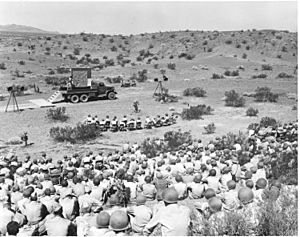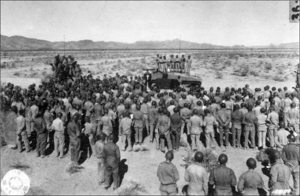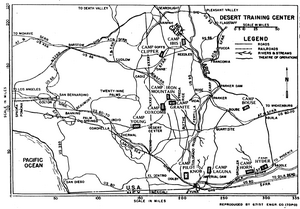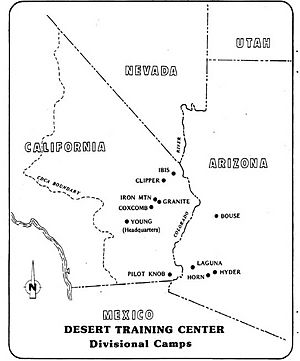Camp Clipper facts for kids
Quick facts for kids Camp Clipper and Camp Essex |
|
|---|---|

Camp Clipper in June 1943, 108th ECB street
|
|
| Location | near Fenner, California |
| Area | 21,537.78 acres |
| Built | 1942 |
| Architect | US Army |
| Reference no. | 985.5 |
| Lua error in Module:Location_map at line 420: attempt to index field 'wikibase' (a nil value). | |
Camp Clipper and Camp Essex were important training sites for the U.S. Army during World War II. They were part of a much larger area called the Desert Training Center in Riverside County, California. The main base for this training center was Camp Young. This is where General Patton and his soldiers were based.
Camp Clipper is now recognized as a California Historical Landmark (No. 985.5). You can find the site of Camp Essex near the Fenner Rest Area in Fenner, California. This is along Interstate 40, about 32 miles (51 km) west of Needles. Both camps were located near the Clipper Mountains, at the southern edge of the Mojave National Preserve. Camp Clipper was a temporary camp. It helped troops as they arrived or left the training area. Camp Essex was named after a small town nearby, Essex, San Bernardino County, California. There was also a 4,500-foot (1,372 m) long Camp Essex Army Airfield close by.
Contents
Why Were These Camps Built?
Camp Essex and Camp Clipper were built in 1942. Their main goal was to get U.S. troops ready for battle. Soldiers trained here to fight in North Africa against the Nazis during World War II. The desert conditions were similar to those in North Africa.
The 93rd Infantry Division trained at Camp Clipper. These troops later fought in the North African campaign. A temporary camp was also set up for the 33rd Infantry Division.
Life at the Camps
When the camps were finished, they had many facilities. There were 36 shower buildings and an outdoor theater. They also had 191 latrines (toilets) and 149 wooden frames for tents. A large 50,000-gallon (189,271-liter) water tank was built. There was also a huge 500,000-gallon (1,892,706-liter) concrete water reservoir. Two wells were dug, each 740 feet (226 m) deep, to supply water. The camp had 14 different training ranges for soldiers to practice.
In 1944, the camp was briefly used for Italian prisoners of war. Camp Essex and Camp Clipper closed on March 16, 1944. Today, the Bureau of Land Management looks after the site. You can still find warning signs about live-fire exercises that the army used to do there.
Who Trained Here?
Many different units trained at these camps.
- The 93rd Infantry Division trained at Camp Essex from July to October 1943.
- The 33rd Infantry Division trained at Camp Clipper from April to July 1943.
Camp Essex Army Airfield
An airfield was built near Camp Essex to help with training. It had two runways, each 4,500 feet (1,372 m) long. These runways were made of steel landing mats. There were also six parking pads at each end. The runways ran north-south, parallel to the old U.S. Route 66 and Camp Clipper.
Small planes like the L-4 Piper Aircraft used the airfield. These planes helped watch the large training grounds from the air. The runways were also long enough for bigger planes used in training. These included the Douglas C-50 cargo plane, Douglas A-20 Havoc, Curtiss P-40 Warhawk, Lockheed P-38 Lightning, and Consolidated B-24 Liberator.
In the early 1950s, the airfield was used privately. But it was not kept up and was abandoned by the late 1950s.
Historical Marker
A special marker stands at the Eastbound Rest Stop in California. It tells the story of the Desert Training Center and Camp Clipper. It says that Camp Clipper was set up in the spring of 1942. It was one of twelve camps built in the deserts of the Southwest. These camps helped train U.S. troops for World War II battles.
The Desert Training Center was like a huge practice battlefield. It covered parts of California, Arizona, and Nevada. Other camps included Young, Coxcomb, Iron Mountain, Ibis, Granite, Pilot Knob, Laguna, Horn, Ryder, Bouse, and Rice. Over 13 infantry divisions and 7 armored divisions, plus many smaller groups, trained in this tough desert environment. The training center operated for almost two years. It closed in early 1944 when the last units went overseas. During this time, over one million American soldiers trained for combat here. The 33rd and 93rd Infantry Divisions were among those who trained at Camp Clipper.







